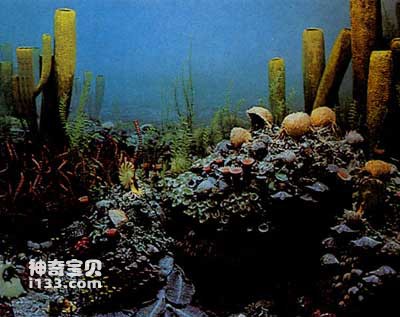About 3.2 billion years ago, single-celled organisms such as bacteria and simple algae appeared in the primitive ocean. For example, cyanobacteria, which are still widely living today, still retain their original prokaryotic state.

Ancient marine animal and plant communities
The emergence of cyanobacteria is almost as important as the emergence of life. Because it can actually absorb sunlight and use solar energy to turn chemicals dissolved in seawater into food. In other words, the cells of cyanobacteria contain chlorophyll, which can perform photosynthesis, synthesize proteins, and release oxygen.
During the period between 1.8 and 1.3 billion years ago, eukaryotes with nuclei - green algae and others - appeared. Later, there were red algae, brown algae, golden algae... They formed a colorful algae world. The emergence of eukaryotes heralded the coming of a bustling and prosperous period of life.

Vibrant primitive marine life
Algae perform photosynthesis, release a large amount of oxygen, and form an ozone layer on the ground, which weakens the threat of ultraviolet rays in sunlight to organisms, makes it possible for aquatic organisms to develop on land, and also provides food for the rise of lower animals.
Some single-celled organisms with flagella, such as Euglena, can use their flagella to continuously rotate and move in the water, and they also have photosensitive eyespots. No wonder people call them Euglena and call them animals. But it also has chlorophyll and can use sunlight for photosynthesis to make food for itself. It is an unambiguous plant. This phenomenon of being both animal-like and plant-like fully proves that the common ancestor of animals and plants is primitive single-celled organisms from ancient times such as Euglena.
Some primitive flagellated organisms later gradually lost their ability to photosynthesize and enhanced their ability to move and feed, thus giving rise to the earliest protozoa, such as the amoebas that still retain their original state more than 1 billion years ago.
Due to the continuous differentiation of cell structure, the nutritional method is divided into two: one develops its own organs for producing nutrients (such as chloroplasts), develops in the direction of complete "autotrophy", and becomes a plant; the other The branch strengthens the ability to move and eat, as well as developed digestive functions, and develops in the direction of "heterotrophy" and becomes an animal.
The separation of plants and animals is the fourth major differentiation in the history of biological evolution. It is these inconspicuous algae with chlorophyll and amoeba without chlorophyll that foreshadow the lush plant kingdom and various animal kingdoms that will appear on the earth. They depend on each other, restrict each other, compete with each other, continue to develop, and become increasingly prosperous.
During this period from 130 to 500 million years ago, shallow seas spread widely on the earth, aquatic animals developed greatly, and it became the heyday of invertebrates. The biggest feature of these aquatic animals is that cells have divided labor to form various organs.
At this time, the most primitive multicellular animals appeared, such as sponges, which are lower multicellular animals. Its whole body has thousands of "windows" and hundreds of holes, so it is also called a porous animal. Each of its small holes is its "Mouth"; Hydra was the first to have a "mouth" and a "stomach"; its kin, jellyfish and jellyfish, had enlarged digestive organs; molluscs (clams, snails) had gills. It uses gills to absorb oxygen dissolved in water, which is the earliest respiratory organ; the body of arthropods (shrimp, crab) has clearly distinguished three parts: head, thorax, and abdomen, and has a complete digestive and reproductive system in the body, as well as simple Nervous system and circulatory system; echinoderms such as starfish, sea urchins, aquarium/sea-cucumbers.html">sea cucumbers, etc., which have the closest lineage to later vertebrates. The ocean world at this time was very lively.
Invertebrates are a general term for lower animals with many categories and various body shapes. Although some of the phylogenetic relationships between them are not very clear, the basic evolutionary outline is clear. Looking at the history of their emergence and development, it is clear that new types continue to emerge and develop, while old types continue to decline and become extinct. They first lived in the ocean, and then transitioned to rivers, lakes and swamps on land. They eventually developed tracheas, lungs, wings and other organs adapted to breathing and flying on land, and finally landed ashore to multiply. This became the basis for later terrestrial spines. The appearance of animals opens the way.
animal tags:
We created this article in conjunction with AI technology, then made sure it was fact-checked and edited by a Animals Top editor.